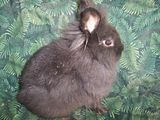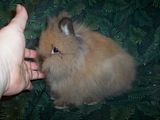courtesy of TinysMom (and Pipp):

El Rey's Angelina

El Rey's New Hope
Lionheads are not currently an accepted breed by ARBA but we are sharing information about them here.
Working Standards
The working standards say that [font="Arial, Helvetica,sans-serif"]Senior Buck & Does, 6 monthsof age and over, are not over 3-3/4 pounds, with an ideal weight of3-1/2 pounds. [/font]
[font="Arial, Helvetica, sans-serif"]JuniorBucks & Does,under 6 months of age, should not beover 3-1/4 pounds. The minimum weight is 1 5/8 pounds.(Juniorsexceeding maximum weight limits may be shown asseniors).[/font]
The ideal body istob[font="Arial, Helvetica,sans-serif"]e short, compact and well roundedwiththe shoulders and chestbroad and well filled,with broad shoulders matching hindquarters.Ideallyposed, the depth at the shoulders should round back tohindquarters of slightly less depth. The lower hips should be wellfilled, theyshould have a high head mount, legs should be ofmedium length and medium bone (relative to the size of the animal), andthe stance is to be high enough to show full chest and mane.[font="Arial, Helvetica, sans-serif"]They are aposed breed (and not shown with their head on the table).[/font][/font]Bodyfaults include a long, narrow body, flat shoulders or hips, chopped offor undercut hindquarters, raciness, and low headset.
[font="Arial, Helvetica, sans-serif"]The headshould be bold, with good width between the eyes. The muzzle should bewell filled. The head should be attached to the body with a high headmount and no visible neck. The should be a slight roundness between theeyes, but the head is not to be round from all directions. Eyes shouldbe bright and bold. Eye color to be as described in the individualvariety. [/font]Headfaults include a long narrow head, pointed or narrow muzzle, lowheadset.
[font="Arial, Helvetica, sans-serif"]The earsshould beshort, well set on top of head, erect, wellfurred,solid witha strong ear base,androunded at the tips. Theyshouldbalance with the head and body. When relaxed ears shouldbecarried in a slight "V".[/font]Ear faults include pointedears, furless ears and ears that don't balance with the body.Disqualifications will includeears exceeding 3 1/2 inches inlength, and wool more than halfway up the ear.
The mane is extremely important. It shouldbe[font="Arial, Helvetica,sans-serif"]a strong, wavy wool with a guardhair tip, with thewooldense enough to make the manefull and prominent.. Crimping of the wool will beespeciallyevident in the junior animals. The prominent portion of the mane (topand sides near the ears) should be at least 2 inches in length onsenior animals, forminga full circle around the head,extending to a "V" at the back of the neck. It may fall intoa fringe between the ears or form a wool cap across the brow. Any woolin the front of the ears should enhance the prominence of the mane, butnot obscure the eye. The face below the wool cap should be clean ofwool. The side trimmings and chest may be noticeably longer.[/font]Mane faults include manesappearing thin[font="Arial, Helvetica,sans-serif"], has gaps; a gradual changeon the forehead between the eyes and ears from normal fur to the woolof the mane. Disqualifications include breaks in the mane,amane that hasnormal fur instead of wool, and woollonger than 1 inch between the eyes. [/font]
[font="Arial, Helvetica, sans-serif"]Thecoat[/font][font="Arial, Helvetica,sans-serif"]should be soft, dense fur of mediumlength, and prime, withlots of life and glossiness. Ideallythe saddle, flanks, and rump of the animal should be clean of wool.Transition wool is allowed on the hips of juniors andseniors.(Transition wool is defined as a significantlyshorter wool on the hips and face). Transition wool is not to exceed 2inches. Coat faultsincludef[/font][font="Arial, Helvetica,sans-serif"]ur that is long, thin, or poor intexture; excessive wool on the flanks of a junior animal.[/font][font="Arial, Helvetica,sans-serif"]Disqualificationsincludewool across the saddle on junior or senior animals,andlack of a distinct break between the wool of the mane andany wool on the hip. [/font]
General Information:
Arden Wetzel holds the first COD (certificate of development) forlionheads. Gail Gibbons of Cimmaron Lionheads holds the second COD andTheresa Mueller of Pridelands holds the third active COD. Bob Whitmanof Rare Bits and Pieces has a COD but has publicly told several peoplethat he has given up lionheads and will not be pursuing his COD.
Unfortunately, Arden Wetzel has only been able to pass the presentationonce with torts. When the other colors failed the second presentation,they were no longer eligible for presentations until the breed ispassed or another COD holder takes over. The torts passed theirpresentation in 2005 but failed again in 2006. If they fail again in2007 then Gail Gibbons will take over and try to have the breed passedwith her first presentation in 2008. New breeds must pass presentationthree times in five years and it is a difficult process.
Currently, the COD colors are: black, tort, chestnut, blue(which has been substituted for orange), fawn, REW (ruby eyed white),sable point and siamese sable. Many ARBA shows will allow all CODcolors to be shown while others will only allow torts. In some areas ofthe country, AOV (any other variety) is allowed to be shown and thiscan include anything from frosted pearl to chinchilla to otters andmore.
Both Gail Gibbons and Theresa Mueller have publicly stated that ifArden Wetzel is able to pass the breed, their certificate will drop totwo colors only (per ARBA regulations). Gail will try to pass sablepoint and REW and Theresa will be trying to pass blue and black.
If you are wanting to show lionheads in your area, it is important totalk to breeders and see what the ARBA sanctioned shows in your areawill allow. Or you can contact show secretaries to see what colors areallowed.
Links:
To find out more information about lionheads you can visit the following sites:
http://www.lionhead.us/ - the official site of the North American Lionhead Rabbit Club
http://www.lionhead.us/info_page.htm to learn about lionheads
http://www.lionhead.us/talk_lionhead.htm a great page about lionhead manes
http://www.lionhead.us/pic_rabbits.htm a photo album of lionheads
http://www.lionhead.us/standard06ARBA7.htm the working standard for breeding lionheads
There are also some email lists out about lionheads:
To Subscribe: [email protected] (the largest list I know of)
To Subscribe:[email protected] (the list I run for folks wholike the other varieties of colors and patterns)

El Rey's Angelina

El Rey's New Hope
Lionheads are not currently an accepted breed by ARBA but we are sharing information about them here.
Working Standards
The working standards say that [font="Arial, Helvetica,sans-serif"]Senior Buck & Does, 6 monthsof age and over, are not over 3-3/4 pounds, with an ideal weight of3-1/2 pounds. [/font]
[font="Arial, Helvetica, sans-serif"]JuniorBucks & Does,under 6 months of age, should not beover 3-1/4 pounds. The minimum weight is 1 5/8 pounds.(Juniorsexceeding maximum weight limits may be shown asseniors).[/font]
The ideal body istob[font="Arial, Helvetica,sans-serif"]e short, compact and well roundedwiththe shoulders and chestbroad and well filled,with broad shoulders matching hindquarters.Ideallyposed, the depth at the shoulders should round back tohindquarters of slightly less depth. The lower hips should be wellfilled, theyshould have a high head mount, legs should be ofmedium length and medium bone (relative to the size of the animal), andthe stance is to be high enough to show full chest and mane.[font="Arial, Helvetica, sans-serif"]They are aposed breed (and not shown with their head on the table).[/font][/font]Bodyfaults include a long, narrow body, flat shoulders or hips, chopped offor undercut hindquarters, raciness, and low headset.
[font="Arial, Helvetica, sans-serif"]The headshould be bold, with good width between the eyes. The muzzle should bewell filled. The head should be attached to the body with a high headmount and no visible neck. The should be a slight roundness between theeyes, but the head is not to be round from all directions. Eyes shouldbe bright and bold. Eye color to be as described in the individualvariety. [/font]Headfaults include a long narrow head, pointed or narrow muzzle, lowheadset.
[font="Arial, Helvetica, sans-serif"]The earsshould beshort, well set on top of head, erect, wellfurred,solid witha strong ear base,androunded at the tips. Theyshouldbalance with the head and body. When relaxed ears shouldbecarried in a slight "V".[/font]Ear faults include pointedears, furless ears and ears that don't balance with the body.Disqualifications will includeears exceeding 3 1/2 inches inlength, and wool more than halfway up the ear.
The mane is extremely important. It shouldbe[font="Arial, Helvetica,sans-serif"]a strong, wavy wool with a guardhair tip, with thewooldense enough to make the manefull and prominent.. Crimping of the wool will beespeciallyevident in the junior animals. The prominent portion of the mane (topand sides near the ears) should be at least 2 inches in length onsenior animals, forminga full circle around the head,extending to a "V" at the back of the neck. It may fall intoa fringe between the ears or form a wool cap across the brow. Any woolin the front of the ears should enhance the prominence of the mane, butnot obscure the eye. The face below the wool cap should be clean ofwool. The side trimmings and chest may be noticeably longer.[/font]Mane faults include manesappearing thin[font="Arial, Helvetica,sans-serif"], has gaps; a gradual changeon the forehead between the eyes and ears from normal fur to the woolof the mane. Disqualifications include breaks in the mane,amane that hasnormal fur instead of wool, and woollonger than 1 inch between the eyes. [/font]
[font="Arial, Helvetica, sans-serif"]Thecoat[/font][font="Arial, Helvetica,sans-serif"]should be soft, dense fur of mediumlength, and prime, withlots of life and glossiness. Ideallythe saddle, flanks, and rump of the animal should be clean of wool.Transition wool is allowed on the hips of juniors andseniors.(Transition wool is defined as a significantlyshorter wool on the hips and face). Transition wool is not to exceed 2inches. Coat faultsincludef[/font][font="Arial, Helvetica,sans-serif"]ur that is long, thin, or poor intexture; excessive wool on the flanks of a junior animal.[/font][font="Arial, Helvetica,sans-serif"]Disqualificationsincludewool across the saddle on junior or senior animals,andlack of a distinct break between the wool of the mane andany wool on the hip. [/font]
General Information:
Arden Wetzel holds the first COD (certificate of development) forlionheads. Gail Gibbons of Cimmaron Lionheads holds the second COD andTheresa Mueller of Pridelands holds the third active COD. Bob Whitmanof Rare Bits and Pieces has a COD but has publicly told several peoplethat he has given up lionheads and will not be pursuing his COD.
Unfortunately, Arden Wetzel has only been able to pass the presentationonce with torts. When the other colors failed the second presentation,they were no longer eligible for presentations until the breed ispassed or another COD holder takes over. The torts passed theirpresentation in 2005 but failed again in 2006. If they fail again in2007 then Gail Gibbons will take over and try to have the breed passedwith her first presentation in 2008. New breeds must pass presentationthree times in five years and it is a difficult process.
Currently, the COD colors are: black, tort, chestnut, blue(which has been substituted for orange), fawn, REW (ruby eyed white),sable point and siamese sable. Many ARBA shows will allow all CODcolors to be shown while others will only allow torts. In some areas ofthe country, AOV (any other variety) is allowed to be shown and thiscan include anything from frosted pearl to chinchilla to otters andmore.
Both Gail Gibbons and Theresa Mueller have publicly stated that ifArden Wetzel is able to pass the breed, their certificate will drop totwo colors only (per ARBA regulations). Gail will try to pass sablepoint and REW and Theresa will be trying to pass blue and black.
If you are wanting to show lionheads in your area, it is important totalk to breeders and see what the ARBA sanctioned shows in your areawill allow. Or you can contact show secretaries to see what colors areallowed.
Links:
To find out more information about lionheads you can visit the following sites:
http://www.lionhead.us/ - the official site of the North American Lionhead Rabbit Club
http://www.lionhead.us/info_page.htm to learn about lionheads
http://www.lionhead.us/talk_lionhead.htm a great page about lionhead manes
http://www.lionhead.us/pic_rabbits.htm a photo album of lionheads
http://www.lionhead.us/standard06ARBA7.htm the working standard for breeding lionheads
There are also some email lists out about lionheads:
To Subscribe: [email protected] (the largest list I know of)
To Subscribe:[email protected] (the list I run for folks wholike the other varieties of colors and patterns)




